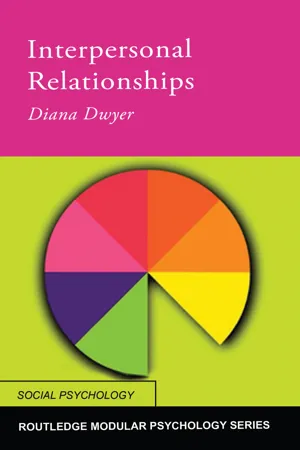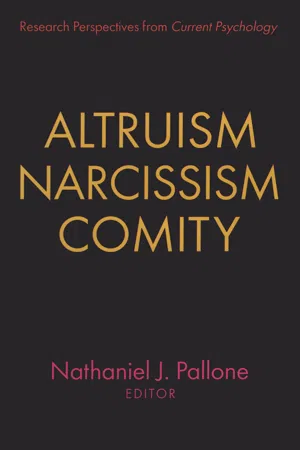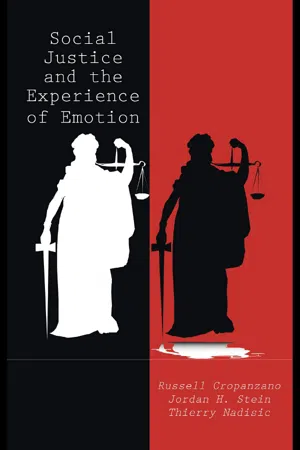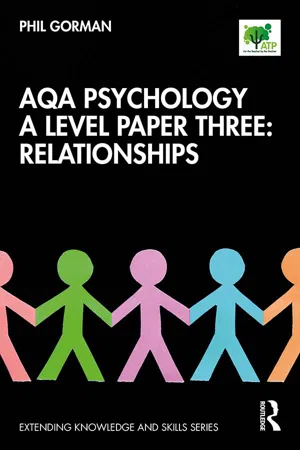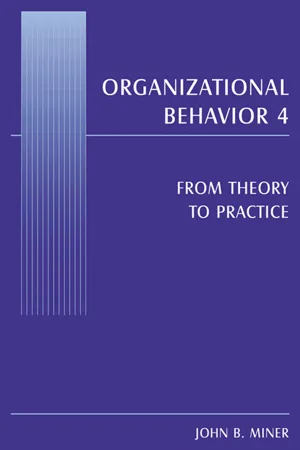Psychology
Equity Theory
Equity Theory is a psychological concept that focuses on the idea of fairness in social exchanges. It suggests that individuals strive to maintain a balance between their inputs (effort, contributions) and outcomes (rewards, benefits) in comparison to others. When perceived inequity occurs, individuals may experience distress and seek to restore fairness in their relationships or situations.
Written by Perlego with AI-assistance
Related key terms
5 Key excerpts on "Equity Theory"
- eBook - ePub
- Diana Dwyer(Author)
- 2013(Publication Date)
- Routledge(Publisher)
Go a bit further through your lives You all form new friendships, you all have romances, some of you get married, some have children. Again, in terms of rewards and costs, what is likely to change? Is it possible to make suggestions, albeit very tentative ones, about the circumstances under which people stay in touch or drift apart?Equity Theory
Equity Theory, formulated by Walster et al. (1978), is a specific version of how social exchange operates in interpersonal relationships and is derived from Homans’ (1961) original social exchange theory. The equity principle states that people will only consider a relationship to be ‘fair’ and satisfactory if what they gain from a relationship reflects what they put in. Equity is not the same as equality. If one partner puts more into the relationship, they should get more out of it. If this is not the case, they feel exploited or that they are taking unfair advantage of their partner.Equity Theory, therefore, predicts that a relationship in which a partner is overbenefited or underbenefited will not be a happy one. Underbenefited individuals tend to feel angry, resentful and deprived. Those who are overbenefited may feel guilty and uncomfortable. Although both imbalances are unhappy states, it is not surprising that being underbenefited leads to greater dissatisfaction than being overbenefited (Hatfield et al., 1982). People prefer to receive too much rather than too little, even if it makes them feel uneasy.Hatfield et al. (1985) have devised the Hatfield Global Measure in order to assess levels of equity. People are asked to assess what they contribute to and what they derive from their relationship compared to the input and output of their partner and whether, as a consequence, they deem their relationship to be a fair one. Research evidence supports Equity Theory. Hatfield et al. - eBook - ePub
- Nathaniel Pallone(Author)
- 2017(Publication Date)
- Routledge(Publisher)
1 Equity, Justice, and Altruism Graham F. Wagstaff Is altruism a justice norm? Is justice based on selfishness? And if justice is based on selfishness, can altruism be morally right, yet unjust? I doubt whether many modern psychologists would be prepared to offer an answer to either of these questions with any degree of conviction. A few decades ago, however, things might have seemed rather different. The Decline of Equity During the 1960s and early 1970s, the psychological study of justice was dominated by the theory of psychological equity. Indeed, some psychologists saw the equity principle as the basic principle of justice; a principle which governs not only economic relationships between people, but also social relationships (Adams, 1963; 1965; Austin and Walster, 1974; Walster, Berscheid, and Walster, 1973; Walster and Walster, 1975; Walster, Walster, and Berscheid, 1978; Walster, Walster, and Traupman, 1978; Hatfield, Utne, and Traupman, 1979). In its basic form, the equity principle states that a relationship between two people is just or fair when individuals who have made large contributions receive large outcomes, and those who have made small contributions receive small outcomes. The contributions or inputs can be either assets which entitle one to rewards, or liabilities which incur penalties. So, for example, if you work harder than someone else you should receive more than them, and if you commit a crime, the more serious the crime, the more you should be punished. Importantly, however, when describing Equity Theory, Hatfield (previously Walster) and her colleagues start from the fundamental assumption that man is selfish (see Walster et al., 1973, p. 151 ; Walster et al., 1978, p. 7). The central idea is that individuals will try to maximize their outcomes (outcomes equal rewards minus costs), and they can do this best by evolving accepted systems, or social contracts, for equitably apportioning resources among members - eBook - ePub
- Russell Cropanzano, Jordan H. Stein, Thierry Nadisic(Authors)
- 2011(Publication Date)
- Routledge(Publisher)
2 are their respective inputs. In good Aristotelian fashion, each person gets what they are entitled to when two ratios agree. A noteworthy feature of Equity Theory is that outcomes are not evaluated in isolation. They are understood via a social comparison process (Austin, 1977). Objective identical results could be more or less fair depending upon the standard of comparison (Ambrose, Harland, & Kulik, 1991; Kulik & Ambrose, 1992).Equity Theory is a quintessentially “hot” model of human behavior; affective states serve an important mediating mechanism. An imbalance in the ratios triggers an unpleasant physical state. Walster, Berscheid, and Walster (1973, p. 153) explained as follows: “When individuals find themselves participating inequitable relationships, they become distressed. The more inequitable the relationship, the more distress individuals feel.” There is even evidence that inequity produces measurable physical activation. Markovsky (1988) took physiological assessments of laboratory subjects who either had or had not been rewarded fairly. When these groups were compared, Markovsky found that inequity produced an elevated galvanic skin response (GSR), indicative of somatic arousal. However, contrary to Markovsky’s predictions, the two groups showed no differences in heart rate.In any case, the affect that occurs when an inequity is experienced is presumed to be unpleasant. Since the feeling is distasteful, individuals are motivated to reduce it. As Mowday and Colwell put it (2003, p. 68): “Inequitable treatment causes tension or distress, and people are motivated to do something about it.” The unpleasant tension is reduced by restoring equality to the ratios. This can be accomplished by acting on any of the terms in the equation, and the responses can be behavioral or cognitive. This leads to a number of predictions. The most obvious finding has to do with under - Phil Gorman(Author)
- 2020(Publication Date)
- Routledge(Publisher)
Individuals who want to have an unfair balance of inputs and outcomes in a relationship in their own favour. Equality The balance between what you put in and get out being exactly the same, rather than just fairly distributed, which is equity. Equity sensitive Individuals who want to have a fair balance of inputs and outcomes in their relationship. Equity Theory A theory of relationships that suggests that fairness is important for a satisfying relationship. Gender-role self-stereotyping Your own beliefs about your gender role conform to the traditional/common beliefs about it. Individualistic cultures Societies that are based on individual achievement and personal gain. Inequity What is put in and taken out by each partner isn’t fairly distributed. Inputs and outcomes The balance between how much you give to a relationship compared to how much you get out. Over-benefitting Getting significantly more out of a relationship than you put in. Priming A technique used in some experiments to provide people with a stimulus that gets them thinking about a particular topic, which they can then be tested on. Retrospective data Information that has been gathered about events that happened at some time in the past and may be difficult to accurately recall now. Social exchange theory A theory that suggests that people in a relationship attempt to minimise costs and maximise benefits. Under-benefitting Getting significantly less out of a relationship than you put in.Plenary: Exam-style questions and answers with advisory comments
Question 1.Explain what is meant by the term equity in relation to romantic relationships?[2 marks]Marks for this question: AO1 = 2Advice: In a question like this, it’s important to make sure you are making it clear how this relates to psychology, so it will probably require an example. There is no need to provide any analysis or evaluation as both marks are for AO1: Knowledge and understanding.- eBook - ePub
Organizational Behavior 4
From Theory to Practice
- John B. Miner(Author)
- 2015(Publication Date)
- Routledge(Publisher)
A majority of the research comparing equity and expectancy approaches has been carried out with major league baseball and basketball players who are approaching free-agency (see Bretz and Thomas 1992; Harder 1991). This research indicates that under-reward performance effects will occur to the extent that they do not jeopardize future rewards; but if they do, then avenues other than performance will be utilized to achieve equity. Over-reward clearly has its effects, and over an extended period of time. Perceived inequities lead to discontent, can influence performance, and result in both trades and leaving the field (literally). But expectations of future rewards exert a motivational influence as well. The two theories thus seem to complement each other.IMPLICATIONS FOR COMPENSATION ADMINISTRATION AND TRAININGSpecifying what the impact of Equity Theory has been, and is, on practice is a difficult task. The theory is widely known among compensation specialists, and equity considerations typically are given major attention in setting pay scales, usually with a view to maintaining equity. Yet it is hard to determine cause-and-effect relationships, and there is no generally established or widely publicized procedure that can be directly linked to Adams or to Equity Theory. It would appear that compensation practitioners have been well aware of the importance of equity considerations for their work for many years. The formulations of Adams and those who have followed his lead have had an uncertain impact on existing practice. However, this situation says nothing about the potential utility of the theory.In view of the level of research support for Equity Theory, one could hope that it might provide the basis for major breakthroughs in management practice. This expectation is further increased because the two motives involved, guilt and anger reduction, are major influences on what people do. There can be little doubt that the theory deals with motivational processes that relate to large segments of human behavior.CompensationOne obvious application is to use the theory as a guide in introducing changed circumstances in the workplace, so that improved quality or quantity of work will result. This was Adams’s objective when, as an employee of the General Electric Company, he undertook the early research on pay-performance relationships, and his writing clearly indicates his belief that this is feasible. Yet there appear to be no clear accounts of this type of application in the literature.
Index pages curate the most relevant extracts from our library of academic textbooks. They’ve been created using an in-house natural language model (NLM), each adding context and meaning to key research topics.
